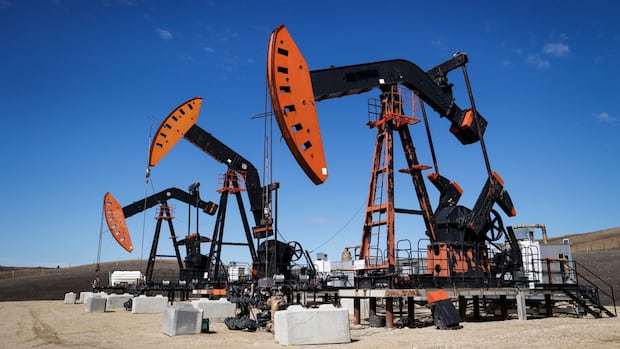A steep drop in oil prices in the first months of the year has undermined any plans for oil companies to “drill, baby drill.”
But reaction to the plunging price of crude has played out differently in Canada versus the U.S, with companies south of the border eyeing production cuts while the Canadian sector holds steady.
Since the beginning of the year, the benchmark price of a barrel of oil has tumbled from a high of $80 US a barrel to around $60 US this week.
The dip in oil prices has been due, in part, to the trade policies coming out of the White House, according to Max Pyziur, director of research with the Energy Policy Research Foundation, a U.S. energy think-tank.
While U.S. President Donald Trump campaigned on a “drill, baby, drill” platform and appointed an industry executive as the country’s energy secretary, the tumult of his trade policy has led to widespread market uncertainty and fears of a possible recession, which would mean lower demand for oil.
“It’s ubiquitous,” said Pyziur, who noted that many companies ranging from FedEx to Kellogg have lowered their forecasts due to broader economic uncertainty.
The downward pressure on oil prices has been compounded by a decision from OPEC+, a group of major oil-exporting nations, to loosen supply constraints and bring more oil onto the market.
“If you’ve got weak demand and more supply, it’s created a concern that we’re going to have excess supply and that’s been driving down prices,” said Randy Ollenberger, managing director of oil and gas research with BMO Capital Markets.
In the U.S., Pyziur said he expects companies will start lowering production.

In a recent letter to shareholders, the head of the largest independent oil producer in the Permian Basin said he believes the industry is at a “tipping point” for U.S. oil production at current prices.
“It is likely that U.S. onshore oil production has peaked and will begin to decline this quarter,” said Travis Stice, CEO of Diamondback Energy, in a letter to shareholders, who said that company is dropping three rigs and one crew this quarter.
“To use a driving analogy, we are taking our foot off the accelerator as we approach a red light.”
ConocoPhillips, whose operations are largely concentrated in the U.S., announced this week it was cutting its capital budget from $12.9 billion US to a range of $12.3 billion US to $12.6 billion US due to “economic volatility.”
U.S. vs. Canada
But that’s in the U.S., where the bulk of oil production involves shale wells, most of them in the Permian Basin, located in western Texas and southeastern New Mexico. Shale wells decline quickly, meaning companies have to keep drilling new ones just to maintain production.
“The Permian, right, it’s a running treadmill,” said Mark Oberstoetter, head of North American upstream research with Wood Mackenzie.
In comparison, Canadian oil production is dominated by the oilsands. The output of these wells and mines don’t decline nearly as quickly. That means while it costs a lot of money upfront to build these facilities, they generally don’t require much new investment to keep going.
Over the last week, the price of oil has fallen below the cost of profitably pulling oil out of the ground in the U.S. According to a survey of oil companies by the Federal Reserve Bank of Dallas, this break-even point is around $65 US per barrel in Texas. The market price for West Texas Intermediate, a widely used benchmark, currently hovers at around $59 US.
Meanwhile, in Canada, conventional mid-sized oil producers often have a break-even price in the $50 US to $55 US per barrel range. Oilsands companies can withstand much lower prices.

On Thursday, the country’s largest oil and natural gas producer, Canadian Natural Resources, said it could still cover maintenance capital and dividends to shareholders in the per-barrel range of the low- to mid-$40s.
“The largest companies here in Canada … they have cost structures that are among the best in the world,” said Ollenberger, with BMO Capital Markets.
“They can withstand WTI prices in the range of $40 [US] and still have enough cash flow to maintain production.”
In recent years, oil prices have soared to the extent that companies have at times been compared to broken bank machines. But unlike in previous boom times, companies have been conservative, opting to pay down debt and buy back shares rather than spend cash on new projects.
“I think we had already, even before the downturn, put ourselves into a defensive position,” said Brian Schmidt, CEO of Calgary-based Tamarack Valley Energy, in an interview.
“We’re not planning on shutting any rigs down or changing our plans yet. And it largely is because our company can tolerate, is quite profitable, at low prices.”
For now, Pyziur, with the U.S. energy think-tank, said companies should expect more tumult in prices at least until the midterm elections.
He also said that as some U.S. companies look to ramp down production, Canadian oilsands producers might be able to capture a greater share of the market.
“That, I think, is an opportunity for Canadian upstream producers.”
